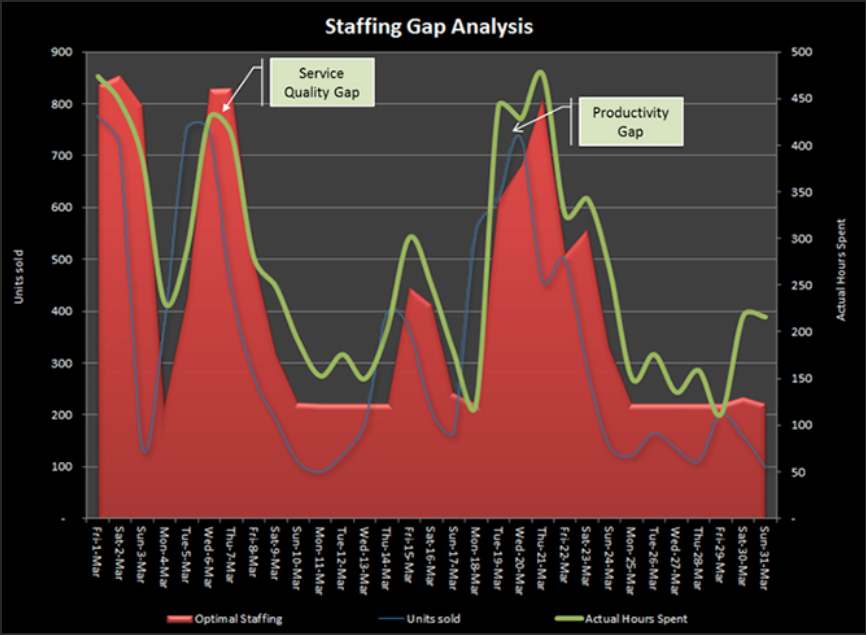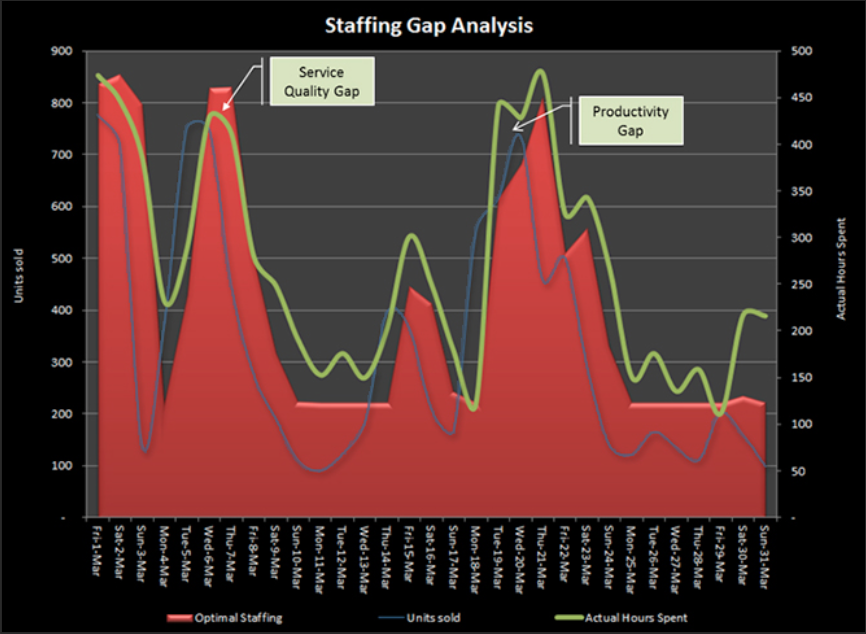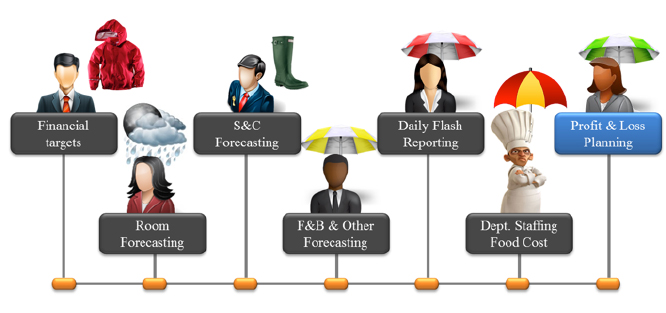Hospitality Productivity Management – a necessity for increased profitability and service quality
For many, when talking about productivity management in hospitality it appears to be inappropriate like swearing in a church. Many hoteliers unfortunately assume that increasing productivity is synonymous with deteriorating service quality or pushing their employees to work even harder. It doesn’t have to be like that. In fact, in this article, I argue that good productivity management is a prerequisite to viably improve (or protect) both profit and good service quality. Moreover, it also contributes to more predictable planning, which in turn means job safety and well-being for the employees.
In the article “Revenue Management – a necessary evil, but is not sufficient to deliver profitability,” I advocate that focus on revenue management is no longer sufficient to deliver profitable operations. The main reason is that the market has become increasingly transparent and sufficiently efficient (i.e. the price of a room at any given time reflects practically all the available information). The consequence is that many hotels in effect fail to raise the price in-line with a higher cost level in order to deliver the desired profit. To resist margin pressure on the bottom-line and still be viable, hotels must adopt innovative technologies, processes and new methods to increase productivity without gambling with service quality or pushing employees to work harder. In my opinion, this is feasible, but it requires that productivity management get significantly greater management focus than has been the case – e.g. the same focus level as Revenue Management has received in the last 20 years. If for every dollar in cost, 10 dollars must be sold to achieve the same contribution margin at net operating profit, it goes without saying that it is also meaningful to have good productivity management on the leadership agenda.
Productivity is usually defined as the number of units produced per time unit (hour, day or FTE). For example, rooms per maid-hour or guests per waiter-hour. Unlike the manufacturing industry, hospitality unfortunately has few and not widespread standards and measurement systems. This complicates the comparison between hotels or even between departments within the same organization. The fact that there is no prominent professional forum in the industry on this subject – as the case is with Revenue Management – is also symptomatic of the lack of attention the discipline is given. Without such a fact-based foundation, is it best to manage by educated guess, and not by a systematic effort to drive continuous improvement and targeted innovation?
Hotel operations face some additional important constraints that companies in other industries do not have to deal with in the pursuit of serving fluctuating demand. These include among other things:
- What is produced is highly perishable and cannot be stored for a long time, but must be sold on the day or at latest a couple of days after (for example, rooms and food);
- In some areas, the resource must be utilized there and then (e.g. waiters in the restaurant or therapists in the spa area);
- Make-to-order production approach with lead-time cannot be applied like the case is for, e.g. car manufacturing and other industries.
/
To prevent low productivity (waste) and / or deteriorating quality, it is crucial that the hotel is able to staff correctly so that goods and services are available when guests need them – there and then.
Productivity management has become even more challenging – and more critical — as the planning horizon is becoming shorter because of the significantly narrower booking window. Increasingly more guests book their itineraries only days before – not weeks or months. This means that hotels need to add a safety margin to avoid poor service due to low staffing.
Never before has it been more important for hotels to introduce a daily updated rolling forecast model to reduce slack in the workforce and thus productivity. Over staffing is not only negative for profitability, but it also affects the service quality if one wishes to manage and deliver the budgeted / forecasted result or productivity over a period of time. Such management implies that the more you over-consume on one or more days, the less is available to spend on the days you actually need the resources. Therefore, it will be at the expense of consistent service quality and, not least, lost upselling opportunities.
Figure 1 shows the reason why the inability to manage staffing and productivity in-line with fluctuating demand is devastating for both profitability and service quality.
/
Over staffing on quiet days has an adverse impact on service quality. The right quality is achieved when all flows like a value stream at a desired pace, so that work is carried out continuously and simultaneously instead of serially with intermediate downtime. Have we not all experienced poor service when sitting alone in a restaurant and there are three waiters whose presence is annoyingly missing? Or, on the other hand, when a restaurant is crowded and chaos prevails around us? The best service is likely to be achieved when the restaurant is about 80% full of guests, and the wait staff continuously flows through the room in unified rhythm. This can be compared the natural watercourse of a river, the quality of the water is best at a certain speed. If the water runs too slow, it becomes blurred due to increased growth rate of microorganisms. If it flows too fast, it gets murky.
Since a hotel has to produce on demand and on time, it is important to study in more detail the key, controllable factors that cause discrepancies between theoretical productivity (production capacity per input/resource unit) and actual outcomes. Based on d2o’s analysis and dependent on which service category of the hotel the department belongs to and the local conditions, the average waste (slack) is on average between 20-40% of the total labor resources consumed.
/
Figure 2 shows the deviation caused by controllable factors as described below.
/
Forecasting Accuracy
To achieve the right staffing levels, the department managers are dependent on getting the right information at the right time from the right sources. For example, the Housekeeping Executive should be able to see changes in real-time to their staff schedule as a result of a Revenue Manager making a change to her rolling forecast. All income of the individual departments and resource drivers are linked to each other, and execution is aligned with the plan, which in turn is based on appropriate productivity targets and service standards.
The main advantage of a rolling forecast is that the organization can adjust its planning and deployment right up to the time of arrival of the guest. The closer one approaches the point of occurrence (arrival), the more accurate the forecast will be.
/
Figure 3 As soon as there is a change to the rolling forecast for rooms or F&B (market forecast), all affected managers will be alerted in real-time about necessary changes to their respective areas of responsibility. This ensures that all seamlessly collaborate in-line with market fluctuations.
/
Resource manageability ratio
Manageability ratio, i.e. the part of the resource capacity that is controllable from day to day, must stand in reasonable proportion to the daily fluctuations in occupancy. If the manageability ratio is less than daily fluctuations, the days of low activity and high minimum staffing will destroy the average productivity.
/
Planning Window
The resource pool should be divided into three levels to enhance the ability to deploy resource optimally:
- Level 1 is the minimum staffing consisting of permanent employees. This requires longest lead-time, and it may also be that the existing roster must be terminated in order to make adjustments.
- Level 2 consists of part-time workers who want to work more if needed, but would like to know about a week in advance when they are required.
- Level 3 consists of standby resources that can be called on the day before, or a couple of days in advance. Overtime and short-term staffing agencies also belong to this level.
Shifts or Static Weekday Staffing Pattern
The pattern of weekday occupancy changes from season to season. It may be due to unexpected change in demand or change in segmentation strategy. These changes may cause the shifts to no longer match the occupancy pattern.
/
Routine and Procedure
At many hotels, extraordinary tasks (such as major cleaning and tidying) are performed on an ad-hoc basis on days with low occupancy or in low season. This approach is suboptimal for both productivity and quality. On days with low occupancy or low season, the companies should deploy minimum resources to maintain productivity. Moreover, it is difficult to keep a good workflow when there are only a few guests staying at the hotel since there are no natural drivers that can facilitate efficient execution. But most important argument against ‘major cleaning’ on days with low occupancy is the one about quality. Should the hotel not be at its best and cleanest when it is full house like our homes when we have guests coming over? Therefore, the best solution is to chop up extraordinary tasks like ‘major cleaning’ into smaller chunks of tasks and incorporate these as part of the daily business as usual.
Business is comprised of a stream of unexpected positive and negative deviations. It is crucial for profitability and service quality that the organization has procedures in place to capitalize on positive deviations to offset against negative deviations. If not, you end up having only negative deviations affecting the productivity level.
/
Great opportunities await leaders who dare to rethink the job of the hotelier and accomplish it in new ways!
It is my contention that the Heads of Department (HODs) have gradually lost their functional relevance. The HODs will be replaced by a few subject matter expert leaders who will also take care of resource and productivity management. The subject matter expert leaders will sit centrally and take responsibility for several hotels or the entire chain. An organizational set-up like this makes it much easier to develop deep expertise within certain key domains and to drive continuous improvement across the portfolio. Today the level of expertise varies a lot among the HODs. They sit at their respective properties, scattered around big towns and small places with limited collaboration, if any at all. It is too costly and inefficient not to mention the headaches associated with key staff turnover and frequent know-how leakages in the organization. With today’s information and collaboration technologies and new ways of working, forming a “Centre of Excellence” for the group is possible, and would yield great benefits. The good news is that most properties already have the necessary infrastructure, so the investment required is quite modest.
Why can’t guests communicate with a highly qualified service employee, who sits centrally and serve the entire chain, when they need help? Imagine a situation where a guest has ‘face time’ via his mobile to ask for an extra pillow. And the service employees will be able to quickly locate the nearest maid (instead of the guests calling front desk, and concierge calling housekeeping, etc. and then maybe the guests get a pillow after 20 minutes if all the links work). Not only will the hotel save resources, but the service guests receive will be far better. The service is available 24 hours a day.
Let us imagine a day in the future where your hotel is optimally staffed and the resulting productivity is approximately equal to the theoretical optimum. How will you solve the problem of continued pressure that will squeeze your margins? Maybe you need to rethink completely around the service concept like Steve Jobs did with the music business: To consider some types of service as a necessary evil. The base premise is that some service types exist only to bridge the gap between the needs of the customers and the product. No guest wants to pay for the service alone. For example: How many would pay just to experience the best check-in and check-out or valet service at a hotel without staying there? Maybe some would even pay a little extra to drop check-in and check-out.
Productivity is much more than just considering what individual employees can produce within a given period. This article touches only a subset of the subject, but it is my hope that it contributes to the consideration of productivity management as a subject that deserves management attention and respect. “Cost-effective service excellence” is not an oxymoron, but a necessity to develop a good business like when Toyota introduced the production method TPS to increase productivity and quality. TPS method is today prevalent in the automotive industry. Essentially, hotel operations are about logistics, or, to put it another way: DoT-QAP (Delivery on Time and Quality as Promised).
You can invest in sending employees to smile and service trainings ten times a year, but it will not help much if the logistics do not work and you do not have accepted standards and measurement systems to direct management focus and effort. Therefore, we work actively with many like-minded in the industry to establish a set of standard key performance indicators covering both productivity and quality, which should be as significant as RevPAR.
/
By Young N. Nguyen
CEO& Founder
d2o
YOUNG N. NGUYEN is CEO & Founder of d2o (www.d2o.com), the provider of innovative performance management methods and software for hotel, resorts, cruise lines and catering companies. d2o currently has over 400 customers in 15 countries as well as mentoring relationships with hotel management colleges and universities worldwide.
/
Click here to get a Norwegian version of this article.







0 Comments